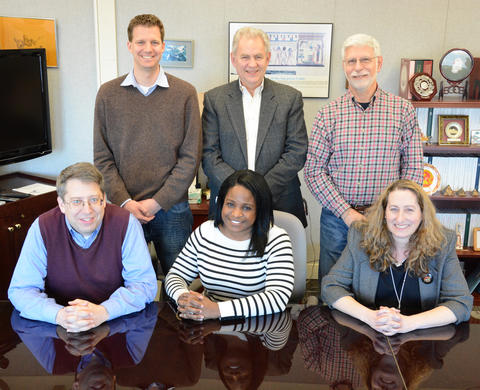
A half dozen of the NIST Forensic Science Planning Committee members: (standing, left to right) John Paul Jones II, Richard Cavanagh, Mark Stolorow; (seated, left to right) John Butler, Melissa Taylor, Barbara Guttman.
Seattle, Wash. – Forensic scientists from around the world flocked here in mid-February for a professional association meeting that was as intriguing as a Sherlock Holmes mystery and as riveting as an episode of CSI – the American Academy of Forensic Sciences (AAFS). I tagged along with my colleagues from the National Institute of Standards and Technology to help spread the word about what NIST does in forensic science.
With more than 900 scientific presentations and thousands of attendees, one person can only experience small slices of the weeklong gathering. I focused my time on the exhibit hall, poster sessions and presentations by NIST scientists. Curious about what they said? Read on for my day-by-day summary.
Tuesday, Feb. 18: Today marked a milestone for the NIST Forensic Science Program. Six of the team members gave a panel presentation on how NIST will bring about 20 independent scientific working groups under a new NIST-administered organization. NIST is in the process of establishing the Organization for Scientific Area Committees, or OSAC, a result of an agreement last year with the Department of Justice. The DOJ recently held the first meeting of the National Commission on Forensic Science. Both the commission and OSAC will work to set standards, guidelines and best practices for forensic science. However, the commission is expected to focus on policy issues while the OSAC is practice-focused. As a result, the criminal justice community and the broader public will be able to place greater confidence in crime lab analyses.
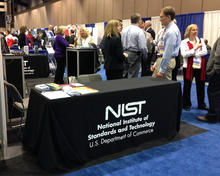
The NIST panel presentation at the AAFS meeting was the first large, public forum for forensic scientists to learn and ask questions about OSAC. With interest in the presentation running high, hundreds of meeting attendees made their way into a ballroom at the Washington State Convention Center.
NIST staff members Mark Stolorow, Rich Cavanagh, Susan Ballou, Barbara Guttman, John Butler and John Paul Jones II were ready with scores of PowerPoint slides on their vision for OSAC. The presentation was also webcast, though not without technical glitches. Fortunately, it was recorded and is now available for viewing online (link removed; no longer active).
The two-hour presentation included about 75 minutes of speaker presentations (see a pdf of the presentation slides) with 45 minutes reserved for questions. During the question and answer session, concerns were expressed about the exclusion of digital evidence from OSAC. Overall, the audience expressed appreciation for the amount of thought that NIST has put into the OSAC plan. If you want to follow developments with OSAC, visit www.nist.gov/forensics/osac.cfm.
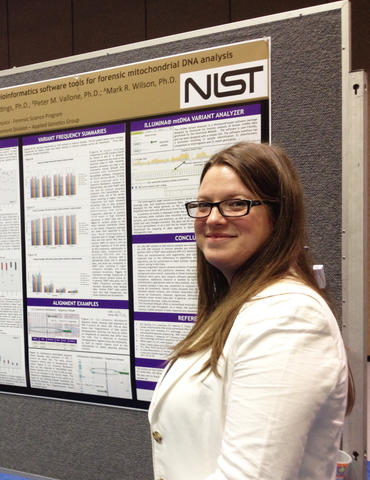
Wednesday, Feb. 19: Conversations about the NIST panel presentation on OSAC continued as the exhibit hall and poster sessions opened today. Meeting attendees who had questions and comments about the OSAC concept came to the NIST exhibit booth, where I spent most of the day. NIST Office of Special Programs Director Rich Cavanagh ably responded to many of these questions. Booth visitors could also watch short NIST videos, pick up information about NIST measurement standards and data, and get electronic copies of NIST forensic science publications.
Taking a break from booth duty, I walked over to the poster session where dozens of scientists were stationed along rows of bulletin boards, ready to explain various research projects. Posters full of graphics and text helped tell their stories, but the opportunity to ask the scientists questions in person is, in my opinion, one the best parts of AAFS. The variety of topics covered here is remarkable too, ranging from the effects of weather on human remains to the ability to detect tiny amounts of hand lotion from a crime scene.
I spoke with Brittania Bintz, a forensic research scientist at Western Carolina University, about work she does in collaboration with NIST to establish a threshold of detection for next generation DNA sequencing instruments. Work like this is important so that crime labs will have all the information they need to accurately interpret results from these instruments.
Today also offered a proud moment for Mark Stolorow, Director of the NIST Law Enforcement Standards Office. During the Criminalistics Section business meeting, he was presented with the AAFS Mary E. Cowan Outstanding Service Award. This award was also acknowledged before the full AAFS membership at its annual business meeting.
Thursday, Feb. 20: I devoted today entirely to attending scientific talks. With a highlighted copy of my list of NIST presentations, I arrived early enough at the convention center to buy a coffee (yes, Seattle's reputation for coffee is well earned).
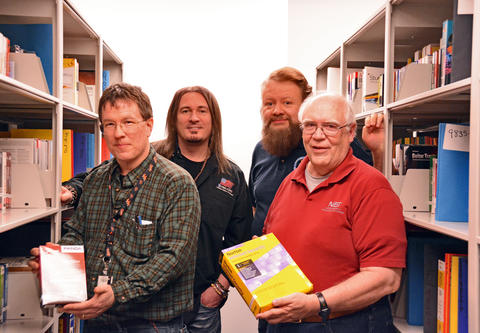
The first talk I attended was on new guidance for preserving biological evidence. The new guidance is the culmination of a working group that NIST convened in 2009. Stephanie Stoiloff, a working group member and Commander of the Forensic Services Bureau for the Miami-Dade Police Department, reviewed best practices and encouraged audience members to use the guidelines. You can learn more about the working group and the guidelines on our website (link removed; no longer active). See the presentation slides (pdf).
With four other NIST speakers giving talks in moderated sessions this morning, I kept an eye on the clock and caught bits of most of them. NIST's Melissa Taylor spoke about how juries perceive statistical information used to qualify evidence. She also gave an update on the Expert Working Group on Human Factors in Handwriting Analysis. John Paul Jones II spoke on the Future State of Handwriting Examinations (pdf) with recommendations on how to integrate the latest measurement science and statistics into handwriting examinations. At the same time, James Yen was speaking on NIST work for the National Ballistic Imaging Comparison Project (pdf).
After a short lunch break and another pass through the poster session, I listened to a moderated session on digital and multimedia sciences. NIST's digital forensics program had a large presence in the digital and multimedia sciences session with five talks detailing various aspects of NIST's work in this area. Rick Ayers presented NIST's work in testing forensic tools for extracting data from mobile devices, such as phones and tablets. James Lyle spoke about a new set of reference materials for testing file carving tools – tools used to recover partial and/or deleted files. Doug White spoke about NIST's National Software Reference Library and its associated projects, including digital preservation and how approximate matching can be used to find similar files. John Tebbutt described a novel approach to cataloging and characterizing software artifacts on computer systems. Alex Nelson went on to describe how specific changes in the structure of the Windows(R) Registry – without reference to the content – indicate the presence of software on a computer, even if the software has since been uninstalled. You can view Doug and John's presentation slides here. Jim and Rick's presentation slides are here.
Capping the NIST talks today was Mike Coble's presentation on inter-laboratory studies for DNA interpretation. Such studies attempt to determine how forensic scientists interpret and attribute DNA analyses when samples from a crime scene contain DNA from two or more people. See his slides (pdf).
Whew! It was a busy day. Time to go pack for my trip back to the East Coast.
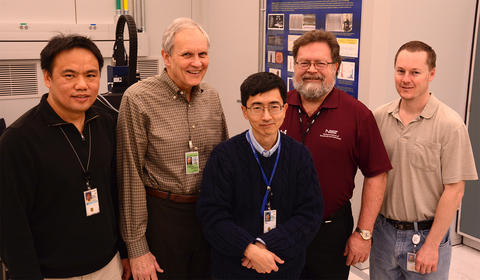
Friday, Feb. 21: Although I was on my way home early today, several of my NIST colleagues remained to share more of their science with the forensics experts attending the meeting. Here's a round-up with photos and links to their presentation slides.
- Robert Thompson led off an early morning moderated session on firearms and toolmarks. That's the forensic specialty that matches bullets and bullet casings to a specific gun. He gave two presentations: "Automatic Identification of Bullet Signatures Based on Consecutive Matching Striae Criteria" (pdf) and "Tests Using the Congruent Matching Cell Method for Optical Image Correlations of Cartridge Cases Fired From Consecutively Manufactured Pistol Slides" (pdf).
- Ted Vorburger followed with a talk on "Reference Bullets and Cartridge Cases for Automated Ballistics Inspection Systems"(pdf).
- Alan Zheng spoke on "Topography Comparisons of Tool Marks Generated by Ten Consecutively Manufactured Chisels and Drift Punches" (pdf).
- And Brian Renegar gave a talk on "An Improved Vacuum Casting Method for the Replication of Reference Bullets" (pdf).
In another early jurisprudence moderated session, John Butler gave a talk on "DNA Mixture Interpretation: History, Challenges, Statistical Approaches, and Solutions."
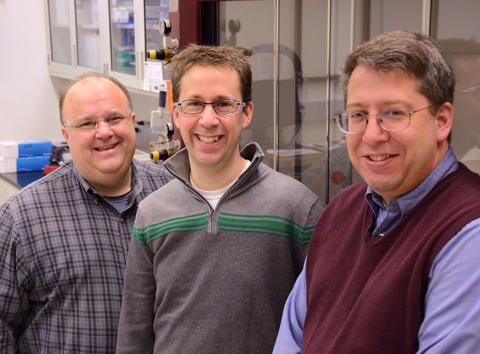
Also on DNA, Pete Vallone spoke on "Characterization of DNA-Based Certified Reference Materials with New and Emerging Technologies" in an afternoon criminalistics moderated session.
Shannan Williams spoke on "Automated Identification Technologies: Improving the Management of Forensic Evidence" (pdf) in a general moderated session.
Joshua Hadler from NIST's Boulder lab, gave a talk of high interest to the aviation community, "Output Characterization of Handheld Lasers Used in Criminal Aircraft Illumination."
Saturday, Feb. 22: Meeting attendees who remained in Seattle for Saturday morning sessions, were rewarded to hear Mark Stolorow give an overview of NIST activities in the forensic sciences (pdf) and Martin Herman talk on "Strategic Research Directions in Forensic Science at the NIST Information Technology Laboratory" (pdf).
This wrap up should give you a sense of how much NIST research is relevant to the many specialties within forensic science disciplines. A year from now, AAFS will be in sunny Orlando. NIST scientists will certainly be there too.

